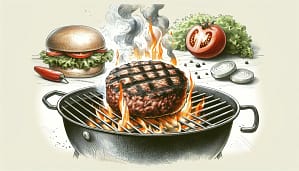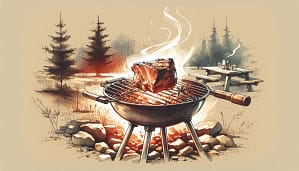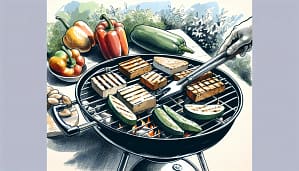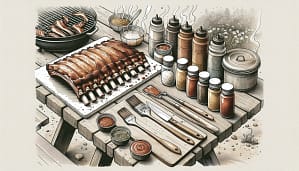How to Season a Flat Top Grill: A Guide
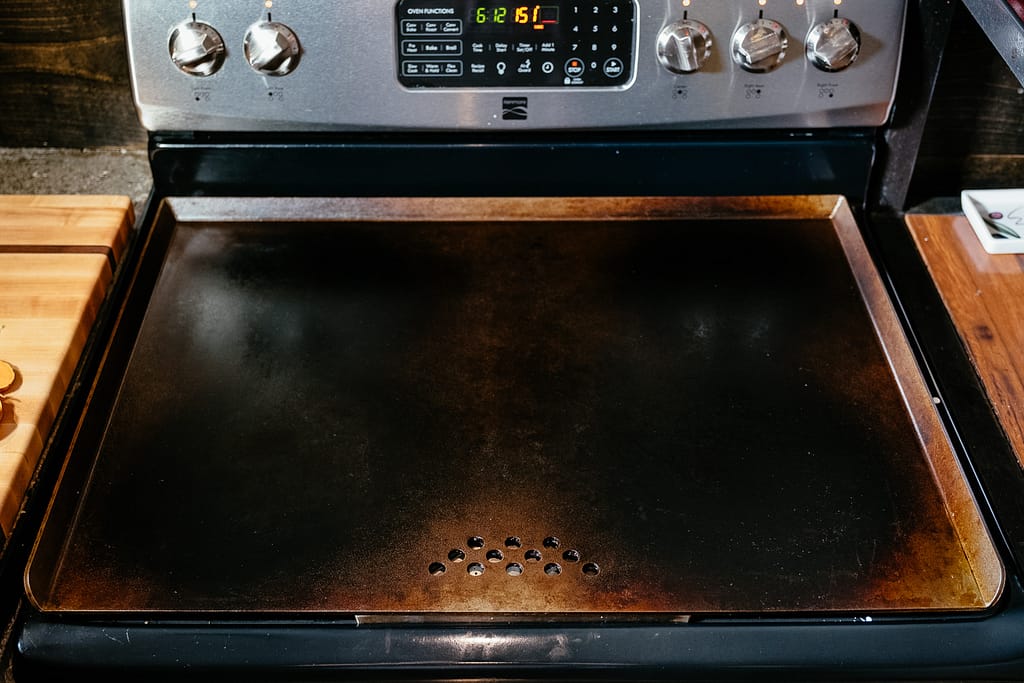
Get read for this grilling season by ... seasoning your grill!
You just got that new flat top grill. Congrats! Now what? You’ve got to season it! This post shows you how.
Introduction to Seasoning a Flat Top Grill
Seasoning a flat top grill is an essential process that not only protects the grill but also enhances the flavor of the food cooked on it. This guide will walk you through the steps to properly season your flat top grill, ensuring that it remains in excellent condition and becomes a reliable tool in your culinary arsenal.
Understanding the Importance of Seasoning
This task involves coating it with oil and heating it until the oil polymerizes on the surface. This creates a non-stick layer that prevents rusting and makes cleaning easier. Regular seasoning is crucial as it continuously improves the surface, reducing the likelihood of food sticking and enhancing the overall cooking experience.
Preparing Your Flat Top Grill for Seasoning
Before you start the seasoning process, it’s important to clean your grill thoroughly. If it’s brand new, wipe the surface with a damp cloth to remove any dust or manufacturing residues. For a used grill, you’ll need to clean it more rigorously. Heat the grill to a high temperature to burn off any food remnants. Then, let it cool slightly and scrub it with a grill stone or scraper. Avoid using soap if possible, as it can strip away the existing seasoned coating. After scrubbing, wipe the surface clean with a cloth or paper towels.
The Seasoning Process
To begin seasoning, select an oil with a high smoke point, such as flaxseed oil, canola oil, or vegetable shortening. These oils are effective because they polymerize quickly and form a durable layer on the metal surface. Apply a thin, even coat of oil across the entire surface of the grill, including the sides. Use a clean cloth or paper towel to spread the oil. Make sure the layer is even and there are no excess pools of oil.
Next, heat the grill to a high temperature, usually between 350°F to 400°F. The oil should start to smoke slightly; this is a sign that the polymerization process is occurring. Maintain this temperature for 30 minutes to an hour, allowing the oil to bake onto the grill’s surface. The grill should start to darken; this is a sign that the seasoning layer is building up.
After the first round, let the grill cool down completely. Then, repeat the process of applying oil and heating it up two or three more times. Each layer of oil you add and bake will further polymerize and strengthen the non-stick coating. It’s important to allow the grill to cool completely between each application to ensure each layer is set properly.
How to Maintain Your Seasoned Flat Top Grill
Once your grill is seasoned, maintaining the surface is straightforward. After each use, allow the grill to cool, then wipe off any food particles or excess grease with a paper towel. For tougher residues, heat the grill slightly and use a scraper gently. It’s advisable to apply a thin layer of oil after cleaning and before storing the grill to protect the surface from moisture and potential rust.
Avoid using harsh chemicals or abrasive tools to clean the seasoned surface, as these can strip the protective layer you’ve built up. With proper maintenance and regular use, your seasoned flat top grill will enhance your cooking for years to come, providing a reliable, non-stick surface for everything from breakfast classics to gourmet dinners.
How to Season a Cast Iron Flat Top Grill?
Seasoning a cast iron flat top grill is a crucial step to ensure its longevity and to enhance its non-stick capabilities. Here’s a detailed guide on how to properly season your cast iron flat top grill.
Cleaning the Grill
Before you begin the seasoning process, it’s important to start with a clean surface. If your grill is new, wipe it down with a damp cloth to remove any dust, debris, or protective coatings from the manufacturer. For a used grill, you’ll need to clean it more thoroughly to remove old food residues and any rust that may have formed. Heat the grill to a medium-high temperature to help loosen any stuck-on food. After the grill has warmed, use a grill brush or scraper to scrub off all residues. Once the debris is removed, allow the grill to cool, then wipe it down with a damp cloth to pick up any remaining particles and dust.
Applying Oil
Once your cast iron grill is clean and dry, apply a thin layer of cooking oil to the entire surface, including the sides. Oils with high smoke points, like flaxseed, canola, or grapeseed oil, are ideal because they polymerize well, forming a hard, protective finish on the surface. Use a paper towel or a clean rag to spread the oil evenly, making sure the entire surface is coated without leaving excess oil pooled on the surface.
Heating the Grill
Turn on your grill to a medium-high setting, around 350°F to 400°F. The oil will begin to smoke as it reaches its smoke point; this is normal and an important part of the process. The smoke indicates that the oil is breaking down and bonding to the cast iron, creating a polymerized layer. Allow the grill to heat until it stops smoking, which typically takes about 30 to 60 minutes. This process creates the initial layer of seasoning.
Repeating the Process
After the grill has cooled completely, assess the surface. It should look slightly darker. For a more robust seasoning, you’ll want to repeat the oiling and heating steps several times. Three to four rounds are generally recommended to build up a strong layer of seasoning. Each cycle enhances the non-stick properties and protects the metal from moisture and rust.
Maintaining Your Seasoned Grill
To maintain the seasoning on your cast iron flat top grill, it’s important to clean it properly after each use. While the grill is still warm (but not hot), use a scraper to remove any food particles. Avoid using soap and water as these can strip the seasoning. If needed, you can rinse with hot water and immediately dry and oil the surface lightly.
Each time you use the grill, the seasoning will improve, as the oils and fats from cooking continue to build up on the surface. If you notice any spots where food starts to stick or if the finish looks dull, simply go through the seasoning process again with a light coat of oil.
Conclusion
Seasoning your flat top grill is a key step in ensuring its longevity and performance. By following the steps outlined above, you’ll create a durable, non-stick cooking surface that makes cooking and cleanup easier and more enjoyable. Remember, the effort you put into seasoning and maintaining your grill will pay off in delicious meals and trouble-free cooking experiences.
FAQs
How to Season a Blackstone Flat Top Grill?
Seasoning a Blackstone flat top grill is a critical step to ensure optimal performance, longevity, and non-stick cooking surfaces. This process coats the grill with a layer of oil that polymerizes, creating a durable barrier that prevents rust and makes cooking and cleanup easier. Here’s how to season your Blackstone flat top grill:
Step 1: Initial Cleaning
Before you season your Blackstone grill for the first time, it’s important to thoroughly clean it to remove any residues or protective coatings left from the manufacturing process.
- Wash the Grill: Although Blackstone typically recommends against using soap on the cooking surface after initial use, for the very first time, washing with mild dish soap and warm water can help to ensure any residues are removed. Use a sponge or cloth to gently scrub the surface.
- Rinse and Dry: Rinse the surface well with clean water to remove any soap and debris. Dry the surface completely with a towel or allow it to air dry.
Step 2: Apply Oil
- Choose the Right Oil: Use an oil with a high smoke point such as canola, flaxseed, or vegetable oil. These oils are ideal because they form a durable layer when heated.
- Coat the Surface: Apply a thin layer of oil to the entire surface of the grill, including the sides. You can use a paper towel or a clean cloth to spread the oil evenly. Ensure there are no excess pools of oil as this can lead to uneven seasoning.
Step 3: Heat the Grill
- Heat Your Grill: Turn the burners to high and heat the grill until the oil starts to smoke. This indicates that the oil is bonding to the surface of the metal, which is crucial for a good seasoning layer.
- Maintain the Heat: Keep the grill at this temperature for about 10 to 15 minutes, or until it stops smoking. The surface should look a bit darker.
Step 4: Repeat the Process
Cool and Reapply: Turn off the grill and let it cool completely. Once cool, apply another thin layer of oil and repeat the heating process. For a new grill, it’s recommended to repeat this oiling and heating cycle three to four times to establish a strong initial seasoning.
Step 5: Ongoing Maintenance
- After Each Use: After cooking, while the grill is still warm, scrape off any food particles with a flat grill spatula. Wipe the surface with a paper towel and apply a light coat of oil before storing. This helps maintain the seasoning and protects the surface.
- Regular Upkeep: Periodically, you may need to perform a more thorough reseasoning if the grill surface starts to look dry or food begins sticking. Simply follow the steps above to reinforce the seasoning layer.
Tips
- Avoid Soap After Seasoning: Once your Blackstone grill is seasoned, avoid using soap for cleaning as it can strip the protective oil layer. Instead, use water and a scraper or stone designed for griddles to clean the surface.
- Regular Use Improves Surface: Regular use of your grill helps improve the seasoning. Fats and oils from cooking naturally contribute to the seasoning layer over time.
You’ve read all of this but don’t have a flat top grill yet? We recommend those two Blackstone grill models:
- Blackstone Tabletop Grill – 22 Inch Portable Gas Griddle
- Blackstone 1813 Tabletop Griddle with Stainless Steel Front Plate and Hood – 22 Inches
Once you have a grill, might want to consider these accessories to accompany it!
Happy grilling!
